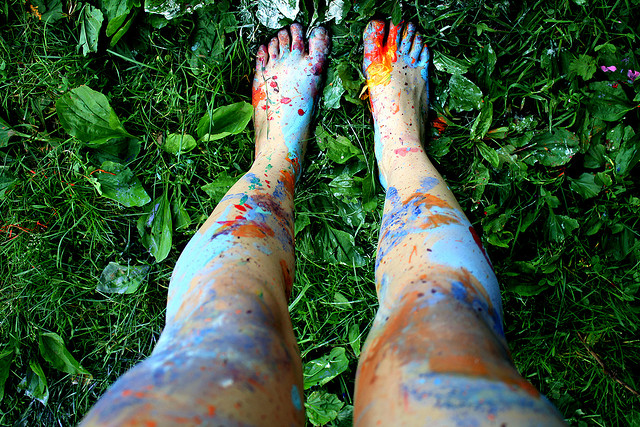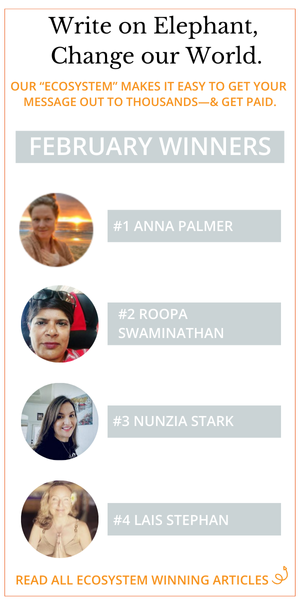The oxford dictionary defines creativity as, “The use of imaginary ideas to create something; inventiveness.”
Some people are defined as creative people, and some are not.
I once had a boss who often said to me, “I’m not a creative person. New ideas aren’t my thing. That’s what you’re here for.” And I took being creative for granted—I’ve always taken it for granted. People have told me since the very beginning, from the moment I was about to hold a pencil in my stubby little hand and etch something out, that I was a creative person.
So it goes without saying that I innately believe it, but it’s not something I’ve examined closely until the last six months.
Why? I’ve never had the luxury to ponder the origins or meaning of my creativity. Working a full time job that employs your creative powers means that everything that exists within that creative reservoir usually gets poured into that space.
I’ve often worked on projects outside of my nine to five job, but in fits and spurts—when the creative itch and the idea struck, I would go with it, and when it stopped, I wouldn’t question it. Even if I hadn’t written a word in six months, I wouldn’t be alarmed. The dry spell was inevitable. You can’t expect it to rain all the time, and similarly, you can’t expect to be creative every moment of your lifetime.
Someone that has always been labeled as a “creative” knows that.
Recently I had six months off work and was inundated by the creative flow—in came one mind-blowing idea after the other. I couldn’t work fast enough or be more inspired. I was writing articles, blogs, books, and pitches about websites. It was like some sort of external fire, seemingly, suddenly lit my mind.
I was under a constant assault, a barrage of ideas.
It was awesome.
It was the single most productive, inspiring and brilliant six months of my life. Most of the time I was spinning like a top, but I was exuberantly spinning like a top. I was energetic, enthusiastic and committed.
I would like to be exactly like that, all the time.
My passion knew no bounds, nor did my curiosity.
With this period of unbridled idealism came a curiosity around the origins of creativity, the meaning of it, the execution of it. As though the universe intercepted this curiosity, a series of books and discussions about the topic were jettisoned into my path. The first was Elizabeth Gilbert’s newest book, Big Magic.
Gilbert is the author of the 2009 best seller Eat Pray Love, which was later made into a film starring Julia Roberts, which was similarly, a hit.
In her new book, Gilbert talks about the creative process, “big magic” being the the capacity to access these creative ideas. She describes them as pure consciousness floating about in the ether, waiting to find their human match.
It seems like an extremely esoteric definition of creativity, but it’s not, really; the ancient Greeks and Romans had a very similar concept, believing that daemons (divine creatures) would visit specific people to place creative thoughts in their minds.
In a modern world all about self-determination, the notion of some fairy placing a thought in your head might seem a little wild. But for anyone who has ever been in the throes of the creative process, or who has ever experienced an extreme light-bulb, angelus of an idea, it doesn’t sound that far fetched. Often, it doesn’t seem like the thought is actually your own; it’s almost as thought it’s been carried to you from afar, and tapped you on the shoulder to whisper its contents in your ear.
To add to the oddity of the creative process, when you’re in the middle of executing an idea— whether its painting a portrait, writing a book, or baking a cake—you often feel like you’re being spirited off to a different place, or like the creative energy flowing through you is not your own.
In Big Magic, Gilbert writes,
“The important thing to understand…about that exhilarating encounter between a human being and a divine creative inspiration is that you cannot expect it to be there all the time…I know this personally because my genius does not keep regular hours…Sometimes I suspect that my genius maybe even working for a bunch of different artists, like some kind of freelance creative contractor.”
I like the idea of having a personal daemon, or at very least, a shared, “uber-like” creative daemon. It’s not the first time I’ve entertained the idea. When I was a little kid, I used to think I had an angel following me around providing me with creative inspiration. I even painted said creative daemon in an art class (you can imagine how entertained my art teacher was by the notion of said creative spectre…not very, to say the least).
And as I grew older, I’ve often thought of my creative daemon as an old friend of mine who passed away from cancer while we were at university.
Somehow giving these ghostly idea-merchants a name and a face helped in the creative process.
Next came a friend of mine who pointed out the creative process was all about the matrix. We were all, he said, in the matrix, and some of us could even see it, and access ideas and messages left for us by us in a different space / time continuum.
Interesting.
As much as I’d like Keanu to wonder into my nine to five wearing a trench coat and Ray Bans, I think it’s an unlikely premise.
Did I need new friends, or was I not well versed enough in the field of theoretical physics?
(A bit of column A, a bit of column B.)
The third idea that happened across my path came through Huff Post Australia, in the form of an article on collective consciousness by Dr. Larry Dossey.
Creative consciousness is an ancient idea, but one that dramatically resurfaced in the US during the nineteenth century. Championed by Ralph Waldo Emerson, the premise is as follows:
“There is one mind common to all individual men…What Plato has thought he may think; what a saint has felt, he may feel; what at any time has befallen any man, he can understand. Who hath access to this universal mind is a party to all that is or can be done, for this is the only sovereign angel.”
Emerson proposes a universal soul or a universal mind, which is by no means groundbreaking stuff—after all, it’s the premise of most religions. But he covers the matrix notion and the daemons at the same time. If you want some theoretical physics thrown in there too, Erwin Schrodinger (Nobel Prize-winning physicist) was a proponent of the idea. He wrote, “the unification of minds or consciousness. Their multiplicity is only apparent, in truth there is only one mind.”
So how do we tap into the universal mind? When can we access an idea?
For me the key to it all is space. To experience that mental clarity of a singular idea, you have to clear the decks. For some people the decks are innately clear. These people can just lead their ever day lives and always have extra space up there in the old noggin’ to tap into the universal mind, others need to relax, meditate, free their mind of other more general and useless chitter-chatter to refocus on idea-land. For a lot of us, this happens through sleep or dreaming. You might need to get into more yoga or tai-chi, again times where you’re seeking to access the pure consciousness.
I don’t necessarily believe in “more” or “less” creative people. A lifetime of creative reinforcement has given me the creative “permission slip” (as Gilbert would say). Someone handed me the hall pass long ago, so I innately believe in my capacity to be creative. Others never got the memo; people have been telling them to stick to the spreadsheets since they were kids, so they’ve never believed there was an opportunity for them to express themselves in a creative way.
But maybe there is no such thing as an inherently creative or non-creative mind; maybe there are just creative ideas floating around out there, ready to be claimed.
One of them could be yours.
Relephant Read:
8 Ways Women can Create Space for Creativity.
Illness: The Restorative Power of Creativity.
21 Quotes to Soothe our Souls & Reignite the Coals of our Creativity.
Author: Lisa Portolan
Author: Editor: Renée Picard
Image: Nicki Varkevisser/Flickr

 Share on bsky
Share on bsky







Read 2 comments and reply